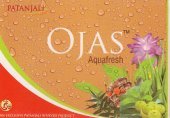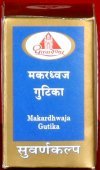Ojas: 21 definitions
Introduction:
Ojas means something in Buddhism, Pali, Hinduism, Sanskrit. If you want to know the exact meaning, history, etymology or English translation of this term then check out the descriptions on this page. Add your comment or reference to a book if you want to contribute to this summary article.
In Hinduism
Ayurveda (science of life)
Rasashastra (Alchemy and Herbo-Mineral preparations)
Source: Wisdom Library: Rasa-śāstraOjas (ओजस्), a Sanskrit technical term, as used in rasaśāstra (medicinal alchemy). It corresponds to ‘water’, or vital fluid, to which rasa and, in this case, mercury is homologised.
Unclassified Ayurveda definitions
Source: Google Books: Ayurveda for health & Well-BeingThe shiny essence (tejas) of all the seven dhatus is Ojas. It is the best part of the seven dhatus collected together. It is sweer (madhu), heavey (guru) cold (shita), soft (mridu), mild, static (sthira), pleasant (prasanna), oily (snigdha), sticky (picchila) and slightly yellowish in colour, where Prana, the vital energy and “Life” resides. Ojas is responsible for the body’s immunity and strength. It is destroyed by anger, over-exertion, malnutrition and lack of food.
Source: Google Books: Essentials of AyurvedaIn Āyurveda, Ojas (ओजस्) holds the important position. It is mentioned as the essence of all the dhātus emanating after śukra. It is neither dhātu nor upadhātu but has independent position. Iti is seated in hṛdaya and is intimately connected with prāṇa. In absence of Ojas no libing being can survive. It supports strength and lustre and is the basic factor of general immunity. Ojas maintains the tone of heart as well as brain. By posisons and alcoholic drinks ojas is affected leading to derangement and ultimate death.
For practical purposes, ojas is said of two types—
- para (superior)
- and apara (inferior).
The affections of the latter cause various symptoms while those of the former cause death.
Source: Google Books: A Practical Approach to the Science of AyurvedaOjas (ओजस्, “vital essence”).—In the transformation of food from rasa-dhātu to śukra-dhātu, ojas releases at every step. Ojas is an essence of all the dhātus, the substance of all hormonal secretions which support the auto-immune system. It means ‘that which invigorates’ and in medical terminology it is also referred to as ‘bala’ or the inner strength (immunity), which resists diseases. Just as bees collect honey from the nectar of flowers, the digestive fire collects ojas from the essence of all dhātus.
Ojas is the seat of ‘prāṇa’ (life-force). Even though it permeates the entire body, it is closely connected to the heart, the prime location of ojas, and from there the arteries carry and distribute it throughout the body.
Ojas is smooth, cool and oily, and has reddish, yellowish and whitish hues. It is of two types:
- para: Located in the heeart, it has eight vital points.
- apara: Permeates in the entire body; its normal quantity is about a handful.
Ojas (ओजस्):—The essence of all seven Dhātus, that is vital for life. Also indicates Bala (immunity). It is of two types: 1. Para, that is present in the heart and, 2. Apara, that is present all over the body. The ten attributes of Ojas are: Guru (heavy), Shīta (cold), Mṛdu (Soft), Ślakṣṇa (smooth), Bahala (abundant), Madhura (sweet), Sthira (stable), Prasanna (bright), Picchila (sticky), Snigdha (unctuous).

Āyurveda (आयुर्वेद, ayurveda) is a branch of Indian science dealing with medicine, herbalism, taxology, anatomy, surgery, alchemy and related topics. Traditional practice of Āyurveda in ancient India dates back to at least the first millenium BC. Literature is commonly written in Sanskrit using various poetic metres.
Natyashastra (theatrics and dramaturgy)
Source: Wisdom Library: Nāṭya-śāstra1) Ojas (ओजस्, “grandeur”) refers to one of the ten merits (guṇa) of a dramatic play (kāvya), according to Nāṭyaśāstra chapter 17. They are characterised by their sweetness and depth of meaning.
2) Ojas (ओजस्, “strength”) refers to one of the twenty-one sandhyantara, or “distinct characteristics of segments (sandhi)” according to the Nāṭyaśāstra chapter 21. The segments are divisions of the plot (itivṛtta or vastu) of a dramatic play (nāṭaka) and consist of sixty-four limbs, known collectively as the sandhyaṅga.
Source: archive.org: Natya ShastraOjas (ओजस्, “grandeur”).—One of the ten guṇas (merits) of a kāvya (dramatic play);—Description of ojas: If a composition otherwise censured and deficient in quality reflects an exalted sense through its words and is rich in sound and sense it becomes an instance of Grandeur (ojas).

Natyashastra (नाट्यशास्त्र, nāṭyaśāstra) refers to both the ancient Indian tradition (shastra) of performing arts, (natya—theatrics, drama, dance, music), as well as the name of a Sanskrit work dealing with these subjects. It also teaches the rules for composing Dramatic plays (nataka), construction and performance of Theater, and Poetic works (kavya).
Kavyashastra (science of poetry)
Source: Shodhganga: Bhismacaritam a critical studyOjas (ओजस्, “grandeur”) or Ojaguṇa refers to one of the different Guṇas (‘qualities’) employed in the Bhīṣmacarita (Bhishma Charitra) which is a mahākāvya (‘epic poem’) written by Hari Narayan Dikshit.—Ojas is the force effected by the presence or profusion of compounds (samāsabhūyastva) which is regarded as the soul of prose. Mammaṭa and Viśvanātha conceive ojas as the glaringness (dīptatva) which causes expansion of heart and which consists in abundant use of compounds, and verbosity.

Kavyashastra (काव्यशास्त्र, kāvyaśāstra) refers to the ancient Indian tradition of poetry (kavya). Canonical literature (shastra) of the includes encyclopedic manuals dealing with prosody, rhetoric and various other guidelines serving to teach the poet how to compose literature.
Shaktism (Shakta philosophy)
Source: Google Books: ManthanabhairavatantramOjas (ओजस्) refers to “vital energy”, according to the Lalitāsahasranāma.—Lalitā’s thousand names are eulogized in the Lalitāsahasranāma, describing the goddess’s spiritual beauty on the analogy of physical, sensuous beauty. [...] As this divine passion itself (kāmarūpiṇī) (796), she embodies the energy of the passion of the union of Śiva and Śakti (kāmakalārūpā) (322). Indeed, the whole of her blissful being is symbolized by the spiritual sexuality of absolute existence through the play of the union of opposites. She is also concretely present in its microcosmic equivalent. Like Kubjikā, Lalitā resides in the fertile male seed (śukra) as its vital energy (ojas). Thus she may be worshipped there, in the vital seed, when it is produced in spiritual intercourse.

Shakta (शाक्त, śākta) or Shaktism (śāktism) represents a tradition of Hinduism where the Goddess (Devi) is revered and worshipped. Shakta literature includes a range of scriptures, including various Agamas and Tantras, although its roots may be traced back to the Vedas.
Jyotisha (astronomy and astrology)
Source: Wisdom Library: Brihat Samhita by VarahamihiraOjas (ओजस्) or Tejas refers to a “bright appearance” [?], according to the Bṛhatsaṃhitā (chapter 15) (“On the nakṣatras—‘asterisms’”), an encyclopedic Sanskrit work written by Varāhamihira mainly focusing on the science of ancient Indian astronomy astronomy (Jyotiṣa).—Accordingly, “Those who are born on the lunar day of Uttarāṣāḍha will be chief ministers or wrestlers; will keep elephants and horses, will be religious; will be men of principles; soldiers; happy and of bright appearance (ojas—caujasā yuktā). Those who are born on the lunar day of Śravaṇa will be cunning, of active habits, efficient workmen, bold, virtuous, god-fearing and truthful”.

Jyotisha (ज्योतिष, jyotiṣa or jyotish) refers to ‘astronomy’ or “Vedic astrology” and represents the fifth of the six Vedangas (additional sciences to be studied along with the Vedas). Jyotisha concerns itself with the study and prediction of the movements of celestial bodies, in order to calculate the auspicious time for rituals and ceremonies.
In Buddhism
Mahayana (major branch of Buddhism)
Source: De Gruyter: A Buddhist Ritual Manual on AgricultureOjas (ओजस्) refers to the “vital fluid”, according to the Vajratuṇḍasamayakalparāja, an ancient Buddhist ritual manual on agriculture from the 5th-century (or earlier), containing various instructions for the Sangha to provide agriculture-related services to laypeople including rain-making, weather control and crop protection.—Accordingly, [as the Bhagavān said to the great Nāga kings]: “Now I will teach the auspicious offering manual which can bring about any effect. [...] Wherever the words are heard, there no cold spells, winds, clouds, thunderbolts and lightning will ever pass. Nobody is able to take away the vital fluid (ojas) or to cause harm again. [...]

Mahayana (महायान, mahāyāna) is a major branch of Buddhism focusing on the path of a Bodhisattva (spiritual aspirants/ enlightened beings). Extant literature is vast and primarely composed in the Sanskrit language. There are many sūtras of which some of the earliest are the various Prajñāpāramitā sūtras.
Languages of India and abroad
Sanskrit dictionary
Source: DDSA: The practical Sanskrit-English dictionaryOjas (ओजस्).—n.
1) Bodily strength, vigour; energy, ability.
2) Vitality; Manusmṛti 1.16.
3) Virility, the generative faculty. The writers on Āyurveda, however, disstinguish between ओजस् (ojas) and शुक्रम् (śukram); cf. क्षीरस्थघृतमिव भिन्न- मोजः शुक्रेण (kṣīrasthaghṛtamiva bhinna- mojaḥ śukreṇa) Ḍalhaṇa. रसादीनां शुक्रान्तानां धातूनां यत् परं तेजस्तत् खलु ओजः (rasādīnāṃ śukrāntānāṃ dhātūnāṃ yat paraṃ tejastat khalu ojaḥ) Sruśr. ओजोविवृद्धौ देहस्य तुष्टि-पुष्टिबलोदयाः (ojovivṛddhau dehasya tuṣṭi-puṣṭibalodayāḥ) Aṣṭāṅga.
4) Splendour, light; Bhāgavata 7.3.23.
5) (In Rhet.) An elaborate form of style, abundance of compounds; (considered by Daṇḍin to be the 'soul of prose'); ओजः समासभूयस्त्वमेतद्गद्यस्य जीवितम् (ojaḥ samāsabhūyastvametadgadyasya jīvitam) Kāv.1.8; see K. P.8 also; said to be of 5 kinds in R. G.
6) (In Astr.) Each alternate sign of the zodiac (as the first, third &c.).
7) Water.
8) Metallic lustre.
9) Manifestation, appearance.
1) Skill in the use of weapons.
11) Speed; एष ह्यतिबलः सैन्ये रथेन पवनौजसा (eṣa hyatibalaḥ sainye rathena pavanaujasā) Rām.7.29.12.
Source: Cologne Digital Sanskrit Dictionaries: Edgerton Buddhist Hybrid Sanskrit DictionaryOjas (ओजस्).—(?) , nt., a high number: Sukhāvatīvyūha 31.2 (by plausible em.; follows srotas, precedes aprameya). Cf. bala (4).
Source: Cologne Digital Sanskrit Dictionaries: Shabda-Sagara Sanskrit-English DictionaryOjas (ओजस्).—n.
(-jaḥ) 1. Light, splendor. 2. Manifestaion, appearance. 3. Strength. 4. Support, stay. 5. Metallic lustre. 6. Vitality, the principle of vital warmth and action diffused throughout the body. 7. Virility, the generative faculty. 8. A form of style, elaborate style, abounding with compounds. 9. (In astrology,) Each alternate sign of the zodiac, first, third, fifth, &c. E. oja to live, and asun affix; or with ac affix oja.
Source: Cologne Digital Sanskrit Dictionaries: Benfey Sanskrit-English DictionaryOjas (ओजस्).—i. e. vaj + as, I. n. 1. Strength, [Matsyopākhyāna] 2. 2. Light, splendour, [Mānavadharmaśāstra] 12, 18. Ii. ojasā (instr.), adv. Powerfully,
Ojas (ओजस्).—[neuter] strength, vigour, energy, power, might; [instrumental] ojasā with might, energetically.
Source: Cologne Digital Sanskrit Dictionaries: Monier-Williams Sanskrit-English Dictionary1) Ojas (ओजस्):—n. (√vaj, or uj; cf. ugra), bodily strength, vigour, energy, ability, power, [Ṛg-veda; Atharva-veda; Taittirīya-saṃhitā; Aitareya-brāhmaṇa; Mahābhārata] etc.
2) vitality (the principle of vital warmth and action throughout the body), [Suśruta] etc.
3) (in [rhetoric]) elaborate style (abounding with compounds)
4) vigorous or emphatic expression, [Sāhitya-darpaṇa; Vāmana’s Kāvyālaṃkāravṛtti]
5) water, [cf. Lexicographers, esp. such as amarasiṃha, halāyudha, hemacandra, etc.]
6) light, splendour, lustre, [cf. Lexicographers, esp. such as amarasiṃha, halāyudha, hemacandra, etc.]
7) manifestation, appearance, [cf. Lexicographers, esp. such as amarasiṃha, halāyudha, hemacandra, etc.]
8) support, [cf. Lexicographers, esp. such as amarasiṃha, halāyudha, hemacandra, etc.]
9) m. Name of a Yakṣa, [Bhāgavata-purāṇa];
10) cf. [Zend] avjaṅh, ‘power’; [Greek] ὑγ-ιές, αὐγ-ή, ἐρι-αυγής; [Latin] vigēre, augere, augur, augus-tus, auxilium; [Gothic] aukan, [English] eke.
Source: Cologne Digital Sanskrit Dictionaries: Yates Sanskrit-English DictionaryOjas (ओजस्):—(jaḥ) 5. n. Light; strength; gold; vitality; high style.
Source: DDSA: Paia-sadda-mahannavo; a comprehensive Prakrit Hindi dictionary (S)Ojas (ओजस्) in the Sanskrit language is related to the Prakrit words: Oya, Oyā.
[Sanskrit to German]
Sanskrit, also spelled संस्कृतम् (saṃskṛtam), is an ancient language of India commonly seen as the grandmother of the Indo-European language family (even English!). Closely allied with Prakrit and Pali, Sanskrit is more exhaustive in both grammar and terms and has the most extensive collection of literature in the world, greatly surpassing its sister-languages Greek and Latin.
See also (Relevant definitions)
Starts with: Ojaguna, Ojakshaya, Ojasen, Ojasi, Ojasina, Ojaska, Ojaskara, Ojassu, Ojastara, Ojasutra, Ojasvant, Ojasvat, Ojasvi, Ojasvin, Ojasvita, Ojasy, Ojasya.
Ends with (+11): Abhibhutyojas, Amitaujas, Amitjas, Anojas, Asamatyojas, Bahvojas, Bhojas, Bhuryojas, Dhrishnvojas, Gatjas, Krishtyojas, Mahjas, Mahojas, Milhojas, Nribhojas, Nyojas, Purubhojas, Shleshmjas, Sriprabhojas, Subhojas.
Full-text (+71): Ojasvin, Oja, Oya, Abhibhutyojas, Amitaujas, Ojoda, Krishtyojas, Vidaujas, Vaj, Ojasvat, Aujasa, Vidojas, Guna, Ojobala, Kaushikyoja, Mahjas, Ojo, Ojasvita, Ojastara, Ojasy.
Relevant text
Search found 39 books and stories containing Ojas; (plurals include: Ojases). You can also click to the full overview containing English textual excerpts. Below are direct links for the most relevant articles:
Malatimadhava (study) (by Jintu Moni Dutta)
Part 4.3b - Ojas Guṇa (Floridity) < [Chapter 2 - Literary Study of the Mālatīmādhava]
Part 4.1-2 - Definition of Guṇa (quality—principal element) < [Chapter 2 - Literary Study of the Mālatīmādhava]
Part 4.3 - Delineation of Guṇa in the Mālatīmāhava (Introduction) < [Chapter 2 - Literary Study of the Mālatīmādhava]
Sahitya-kaumudi by Baladeva Vidyabhushana (by Gaurapada Dāsa)
Text 8.9 < [Chapter 8 - Literary Qualities]
Text 1.6 < [Chapter 1 - The Purpose of Poetry]
Text 8.11 < [Chapter 8 - Literary Qualities]
Jivanandana of Anandaraya Makhin (Study) (by G. D. Jayalakshmi)
Analysis of Guṇas, Vṛttis and Rīti < [Chapter 6 - Dramatic aspects of the Jīvanandana Nāṭaka]
Pāṇḍuroga < [Chapter 4 - Āyurvedic principles in Jīvanandana Nāṭaka]
A History of Indian Philosophy Volume 2 (by Surendranath Dasgupta)
Part 9 - Head and Heart < [Chapter XIII - Speculations in the Medical Schools]
Part 6 - Foetal Development < [Chapter XIII - Speculations in the Medical Schools]
Part 3 - Organs in the Atharva-veda and Āyurveda < [Chapter XIII - Speculations in the Medical Schools]
Hanuman Nataka (critical study) (by Nurima Yeasmin)
Kuntaka’s evaluation of Sanskrit literature (by Nikitha. M)
3.7. Qualities or Guṇas < [Chapter 1 - Vakroktijīvita: A Synoptic Survey]
Related products




